ENTS,
Jess Riddle, Kristine Johnson and I went up Dunn Creek May 15th
to search
for a giant yellow buckeye I found 12 years ago. I had recently
found a
photo of the tree and was determined to revisit it and obtain
new
measurements. As a forest giant I strongly feel yellow buckeye
is an
extremely underrated species. It is very likely that buckeye is
the fourth
largest tree (by volume) in the Smokies, exceeded only by
Tuliptree,
northern red oak and a single cucumbertree. Buckeye commonly
reaches 10'-12'
in girth and 120'-130' tall with several trees known over 15' in
girth and
140' tall. It may enter the "150 Club" with enough
searching, but the
mid-140's seems to be its height limit. Yellow buckeye is a
southern
Appalachian endemic, not known from the Northeast even though it
grows to
the highest elevations in the Smokies. It represents a large
percentage of
the trees in the park's northern hardwood forest type, and it is
also a
common associate in cove forests. It has one of the largest
elevation ranges
of any tree in the park, being found from 800' to over 6500'.
The current
National Champion grows in the Smokies, and has an astounding
378 big tree
point total. In 1998 it was 19'1" in girth and 136' tall.
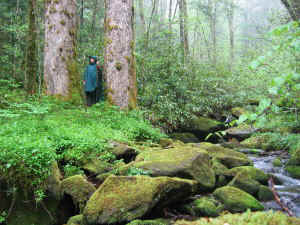
Rainy day at Dunn Creek |
Dunn Creek
is a large creek on the Tennessee side of the Great Smoky
Mountains National Park. It drains the north face of Pinnacle
Lead which is
a western spur off Old Black (6320') and Mount Guyot (6621').
The highest
elevation of the drainage is about 5900' dropping to below 2000'
at the park
border. Dunn Creek is in the heart of the temperate rainforest
section of
the park, receiving untold amounts of rainfall. Most, if not all
of the
watershed has had some logging disturbance but the upper reaches
are "nearly
intact" old-growth forest (see below). The vast majority of
the area we
covered was rich cove and northern hardwoods forest which
transitioned into
spruce above 4000'. Yellow buckeye, red maple, sugar maple,
yellow birch,
cucumbertree, white ash and mountain silverbell dominated the
canopy.
Eastern hemlock was scattered here and there but was still a
significant
component of the forest and reached massive sizes. Mountain and
striped
maple were very common especially on the numerous talus slopes
and boulder
fields. Witch-hobble and occasional gooseberries disguised the
pit-fall
traps between the sphagnum covered rocks. Notably lacking were
bitternut
hickory and yellowwood. These two species are typically very
common at such
elevations and topography- yet not a single tree of either
species was seen.
|
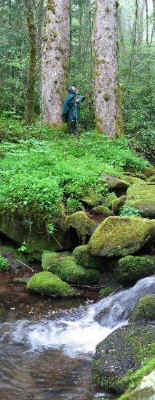
Twin buckeyes on Dunn Creek
|

Basswood
Rib: Jess spotted a huge single stem basswood. It was a hair
over 12" cbh and had an
awesome rib of wood continuing way up the trunk. Basswoods
that large are very
uncommon as a single stem.
|
Selective logging evidence was frequent, with black cherry and
probably
sugar maple cut. Severed tops and notched stumps of the cherries
were still
plainly visible and common, and large sugar maples were nearly
lacking. We
have no idea how the logs were extracted as it is a very remote
area and no
roads were observed. Disappointingly, we were not in true
old-growth forest,
and the extremely heavy hemlock woolly adelgid infestations will
further
diminish the integrity of the forest. Unfortunately, beech bark
disease has
hammered most of the beech. On a positive note, the National
Park Service is
chemically treating many hemlocks on the Albright Grove Loop
Trail further
downstream from where we were. In fact, the park is aggressively
treating
sites throughout the Smokies to save some fine trees and stands.
Two huge
hemlocks found on this trip will likely be added to the list
(see below).
The
temperate rainforest was in full force yesterday even though the
weather
report indicated otherwise. It rained for 8 of the 10 hours of
our 9+ mile
expedition, and the temperature dropped into the 50's.
Unpleasant as it was,
we covered some new ground and found and measured a few
noteworthy trees. I
have to agree with Jess that Dunn Creek is the
"epicenter" of red maple
development. We located two trees over 16' cbh, one over 17' and
the
National Champion which is just ~100 yards from Dunn Creek on
nearby Indian
Camp Creek is over 23' cbh. Huge maples are common and in a
density neither
Jess nor I have ever seen before. Perhaps they are a relic of
selective
logging nearly 100 years ago. (Note: Using core samples, I
documented
selective logging dates on a creek nearby to ca. 1910.)
|

16.7' red maple Dunn Creek |
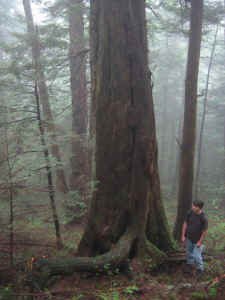
Jess and 16.7' red maple with huge roots |
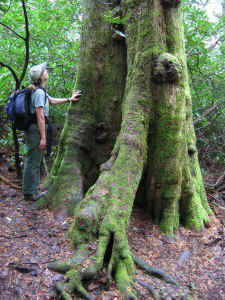
Kristine and a 17'+ red maple Dunn Creek |
The first two hours or so we could not measure anything. Our
rangefinders
would not penetrate the thick cloud enveloping the forest. This
cloud
apparently was an unheeded sign to abort the mission but we
slogged onward.
The rain became steady and heavy when we reached the site of the
huge
buckeye we had come to find. It was still there, but had
literally just
fallen. Fresh scrapes on the surrounding trees and un-wilted
leaves on the
fallen limbs indicated a recent fall. The tree was totally
hollow and a
large portion of the top was already dead.
|
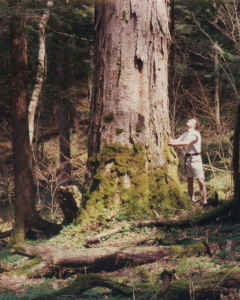
BEFORE- Dunn Creek buckeye ca. 1993 |
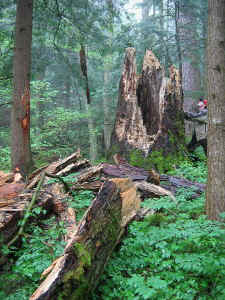
AFTER- Dunn Creek Buckeye May 15 2005 |
While Kristine and I
were having
fun with dendro-forensics Jess spotted a huge hemlock just 30
yards upslope.
We all debated going into the thick rhododendron surrounding it
since we
were already soaked. I was fine with it being a huge tree around
16' cbh
that we could mention in this report. Jess, however, thought
that we should
have a firm measurement to post so he and Kris went over to
check it out
while I measured the height. Well, it turns out the tree was a
new National
Champion! Way to go Jess! The hemlock was not ~16' cbh but a
huge 17'6" in
girth. The height to a very gnarly top was 144.1'. Without a
doubt this tree
will scale 13-1400 cubic feet in wood volume- maybe more.
|

17.5' x 144' Hemlock champion |
Near the
giant hemlock grew a huge, perfectly-formed yellow birch. It had
a
beautiful root flare that supported a massive, straight trunk
with a slight
lean. The crown was very thick with newly expanding leaves all
over. Jess
measured the height from uphill and I measured it from the side.
Measuring
the same top, he put it at 102'2' tall and I put it at 102.1'
tall. I was
very pleased (as usual) with the consistency of the laser
method, and
furthermore we confirmed a new Tennessee State Champion (279
points vs.
255). It is also among the tallest yellow birch known in the
Smokies.
|
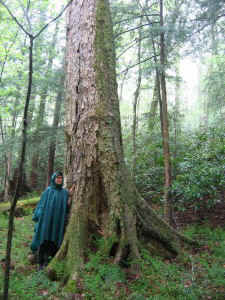
Kristine and a 13.7' X 102' yellow birch Dunn Creek |
We then continued upstream but were deterred by the rain so not
much more
was measured. We had just started to get into the spruce when
the rain and
cold turned us back. We roughed-out one nice spruce to over 130'
but did not
look for the base in the saturated rhododendron. Huge hemlocks
poked up here
and there with several undoubtedly reaching 15' in girth. On the
way down we
relocated a huge twin hemlock I recalled from 1993. It was a
respectable
16'7" in girth. We did not measure the height but it looked
fairly tall.
Point-wise, it would be a co-champion with the huge one
mentioned above but
I believe it to be two trees rather than a low fork. However, it
could be a
single tree- it was just so huge that the evidence was not
visible in the
bark patterns anymore. By volume, this twin would probably have
less than
75% of the other tree. Regardless, it is an imposing chunk of
wood with an
unusual trunk form.

16.7' hemlock twin, Dunn Creek |
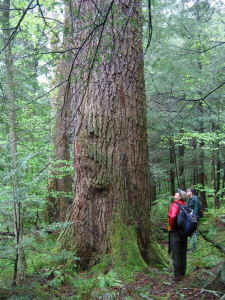
Kristine and the 16.7' hemlock twin Dunn Creek |
Several more huge red maples were spotted and measured. One
exceptionally
thrifty tree had a beautifully fluted trunk with a huge crown.
Though not
particularly tall (119.5') it was impressive growing on the edge
of a steep
bank with a huge columnar trunk and scaly bark. We believed the
tree to be
fairly young and vigorous even though it was over 16' in girth.

16.2' red maple stitch |
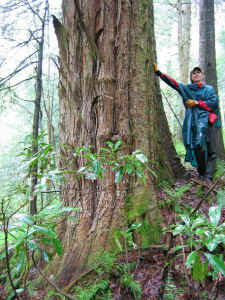
Kristine and a 16.2' X 119' tall red maple Dunn Creek |
On the way out we went around the Albright Grove Loop and
measured several
tuliptrees. The tallest was 167.2' and certainly among the
exceptional for
the area. Heights were 150' or less in general. This grove is
well known for
the giant tuliptrees along the trail. Two of them exceeded 22'
in girth;
however, of these trees one has fallen (ca. 1996) and the other
has just one
live limb left. There are lots more to replace them, but they
have a lot of
growing to do!
Will, Jess, and Kristine
|